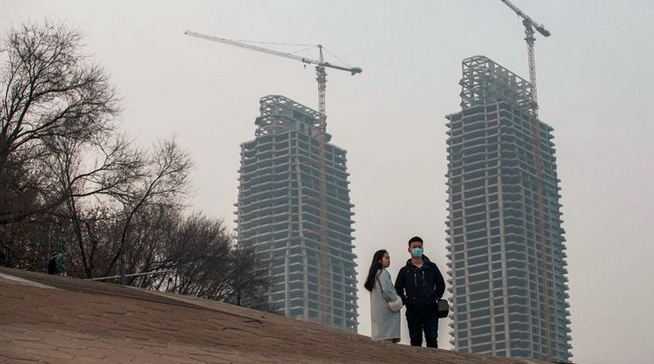If epidemic prevention and control policies are adjusted, and supportive policies for real estate and private investment continue to be introduced and take effect, the downward trend of China's economy is expected to be reversed, and the growth target is also expected to be achieved.
It's almost mid-December again, and the Central Economic Work Conference, which has been held in mid-December in previous years, sets the direction for China's economy and formulates the economic policy for the coming year. This year's situation is relatively special, with the COVID-19 epidemic spreading in many places in the middle of the year, fluctuating, and having a great impact on consumption, investment, and corporate operations. At the same time, the economies of the United States and Europe have fallen into stagflation, leading to a decline in exports. China's economy is facing a dual impact of insufficient domestic demand and weak external demand. The growth forecast for this year is around 3%, which is significantly lower than the growth target of 5.5%. Next year's economic work needs to first reverse the downward trend of domestic demand and also deal with supply shocks and a lack of confidence, which are significant challenges and heavy tasks. To cope with this complex situation, I believe that after the adjustment of epidemic prevention and control policies, and the introduction of positive policies such as the “three arrows” to support real estate financing and the “Opinions on Supporting the Development of Private Investment,” the focus of macroeconomic policy next year will achieve three major shifts: from monetary and financial policy to fiscal policy, from investment to consumption-driven policy, and from focusing on small and medium-sized enterprises to driving the ecological chain with new type of physical enterprises.

Monetary policy continues to be biased towards a loose direction, with loan interest rates hitting a historical low. On November 25th, the central bank announced a comprehensive reduction of the reserve requirement ratio by 25 basis points, aiming to maintain a reasonable and abundant liquidity and to reduce the financing costs of the real economy. After this reduction, the weighted average deposit reserve ratio of financial institutions is about 7.8%, which is lower than that of many emerging economies. In September, the weighted average loan interest rate of financial institutions fell to 4.34%, a new low since the beginning of the statistics. Among them, the weighted average interest rate for personal housing loans fell to 4.34%, which is also the lowest value since the statistics began. In addition, the balance of special re-lending and structural monetary policy tools exceeded 5.5 trillion yuan, and the leverage ratio of the real economy also rose to a high level of 274%.
Due to insufficient effective demand, the transmission from loose money to loose credit is not smooth. On the one hand, the year-on-year increase in M2 and the year-on-year decline in loan balance show a divergence. As of October, the year-on-year growth rate of M2 was 11.8%, while the year-on-year growth rate of the RMB loan balance fell to 11.1%. The rapid growth of money supply has not been transformed into credit expansion. The weak willingness of residents to buy houses and consume loans is the main drag. In October, the increase in long-term loans for residents was 33.2 billion yuan, a new low for the same period since 2009, and it has been less than the same period for 11 consecutive months.
On the other hand, there is a significant divergence between the new loans and new deposits of residents. From January to October, the new RMB loans of the resident sector were only 3.4 trillion yuan, a new low in the past seven years; in contrast, the new RMB deposits increased significantly by 12.7 trillion yuan, a new high since the beginning of the statistics, and nearly 9.4 trillion yuan flowed into fixed deposits and other deposits, showing that residents are actively deleveraging in the face of weak confidence.
In 2023, the focus of macroeconomic policy needs to shift from monetary and financial policy to fiscal policy. Faced with the current situation of insufficient effective demand and poor transmission of monetary policy, it is necessary to further increase the support of fiscal policy for total demand on the basis of maintaining a loose monetary policy in 2023, and to promote the circulation of supply and demand by stimulating demand. Considering the significant decline in land transfer income of local governments this year and the occupation of financial funds in other areas by epidemic prevention expenditures, the local fiscal situation is relatively severe. In 2023, it is necessary to increase the fiscal deficit ratio, for example, from this year's 2.8% to 3.5% or even higher, and to consider issuing 1-2 trillion yuan of special treasury bonds for transfer payments to local governments, which can be used to issue cash subsidies to specific groups of people in difficulty and to issue consumption vouchers to a large number of people.

Under the support of special local bonds and policy-based loans, infrastructure investment has maintained a high growth rate within the year. In the first half of this year, the issuance amount of special local bonds reached 3.4 trillion yuan, with an average of nearly 570 billion yuan per month. Among them, more than 50% was invested in the infrastructure field (such as municipal and industrial park infrastructure, transportation infrastructure, etc.). Since the second half of the year, policy-based financial instruments (quasi-fiscal) have become the main driving force for infrastructure investment. By the end of October, a total of 740 billion yuan has been allocated for two batches of policy-based developmental financial instruments, effectively supplementing the capital of major projects. At the same time, the 800 billion yuan credit quota of policy banks has also helped to support the financing of infrastructure projects. With this promotion, the cumulative growth rate of infrastructure investment in the first 10 months reached 11.4%, and has maintained a double-digit growth rate since June.
However, the multiplier effect of infrastructure investment is small and cannot reverse the downward trend of domestic demand. In terms of investment, there is a divergence in the growth rates of private and state-owned investments. In October, private investment decreased by 1.6% year-on-year, the lowest since May 2020, and the growth rate has been hovering around 0 in the past six months. The government-led infrastructure investment has not driven the recovery of private investment. In terms of consumption, the growth rate of total retail sales of social goods turned negative again, falling to -0.5% in October, with a significant weakening of optional consumer goods. In addition to the multi-point outbreak of the epidemic, the recovery of consumption is also constrained by factors such as employment and income pressure and insufficient consumer confidence. Overall, although the growth rate of infrastructure investment is relatively fast, its multiplier effect is not obvious, and its driving effect on private investment and consumption growth is limited.
In 2023, policy efforts need to increase the support of central fiscal policy to boost consumption. Considering the limited driving effect of infrastructure investment and the greater contribution of consumption to economic growth (the contribution of consumption to economic growth was around 65% in 2021), the focus of policy support in 2023 needs to shift from investment-led to consumption-led. That is, on the basis of tax relief for small and medium-sized enterprises and policy-based loans to support infrastructure investment, the support of central fiscal policy to boost consumption should be increased. In view of the positive role of consumption vouchers issued by various regions this year in boosting consumption, it is important to consider the central fiscal policy through the issuance of special treasury bonds for transfer payments to local governments, supporting local governments to increase the issuance of consumption vouchers, and leveraging the “central fiscal + local subsidies + corporate discounts” combination model to amplify the leverage effect of consumption vouchers and quickly promote the recovery of domestic demand. In addition, another round of energy-saving green home appliances and computer mobile phones and other old-for-new can be carried out, entering the countryside, just to replace the upgrade and replacement of the goods in the last round from 2009-11.

Small and medium-sized enterprises (SMEs) continue to face significant operating pressures. Firstly, insufficient demand has led to a continuous increase in the operating pressure on SMEs. In November, the Purchasing Managers' Index (PMI) for small enterprises in the manufacturing sector further declined to 45.6%, which has been below the boom-bust line for 19 consecutive months. A survey by the National Bureau of Statistics showed that in November, 58.8% of small enterprises reported insufficient market demand, an increase of 1.9 percentage points from the previous month. Secondly, profits of private industrial enterprises continue to decline. From January to October, the cumulative profit of industrial enterprises above a designated size decreased by 3.0% year-on-year, with profits of private industrial enterprises falling to -8.1%. Finally, the implementation of tax reduction, fee reduction, and tax refund policies has effectively offset the impact of the epidemic on business operations. However, in the face of continuous profit decline, there is a “survivor bias” in tax policies, which weakens their role in alleviating business operating pressures.
Enterprise relief policies need to shift from a “direct relief” approach to leveraging the driving effect of the business ecosystem. The report of the 20th National Congress of the Communist Party of China calls for the integration and innovative development of large, medium, and small enterprises in the industrial chain, innovation chain, capital chain, and talent chain. Prior to this, the policy of the “Hand in Hand Action” by the Ministry of Industry and Information Technology and 11 other departments to promote the integration and innovation of large, medium, and small enterprises also explicitly proposed to further leverage the leading role of large enterprises and promote the integration of SMEs into the ecosystem of large enterprises to stimulate the innovation and development vitality of SMEs. This provides a new approach to transforming SME relief policies, focusing on “using large enterprises to lead small ones” to achieve the integration and relief of large, medium, and small enterprises within the ecosystem.
New type of physical enterprises are an important means of “using large enterprises to lead small ones in relief”. With the rapid development of the digital economy, some large platform enterprises, especially those with physical, technological, and ecological network characteristics, known as “new type of physical enterprises”, have become the “leaders” of multiple industrial and supply chains and have formed an integrated development ecosystem with a large number of SMEs. They can be made into a model for the “using large enterprises to lead small ones in relief” model: In terms of the industrial chain, by promoting industrial integration to enhance the ability of SMEs to connect supply and demand, helping SMEs to expand their business scale; In terms of the technology chain, as a service provider for the digital transformation of SMEs, helping SMEs to accelerate digital transformation and improve operational efficiency; In terms of the capital chain, relying on scene, technology, and data advantages to improve the credit assessment of SMEs, helping SMEs to enhance the availability of financing in the supply chain and reduce financing costs.
In order to mobilize the enthusiasm of all parties to a greater extent, make up for the gap in this year's economic growth target, and alleviate the greater employment pressure of college graduates next year, it is expected that the policy level will set the economic growth target for 2023 at 5% or above. If the epidemic prevention and control policies are adjusted, and support policies for real estate, private investment, etc., can continue to be introduced and take effect, and if next year's economic work can promote the above three major transformations, China's economic downturn is expected to be reversed, and the growth target is also expected to be achieved.
Note: The above content and views are for reference only and do not represent any position of our company, nor do they constitute investment advice. Please treat them with caution.







